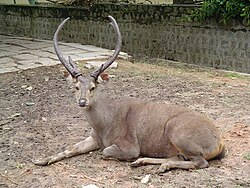Chúi-lo̍k
| ?Chúi-lo̍k | ||||||||||||||||||
|---|---|---|---|---|---|---|---|---|---|---|---|---|---|---|---|---|---|---|

| ||||||||||||||||||
| Seng-bu̍t-ha̍k hun-lūi | ||||||||||||||||||
| ||||||||||||||||||
| Ha̍k-miâ | ||||||||||||||||||
| Cervus unicolor (Kerr, 1792) |
Chúi-lo̍k (Cervus unicolor) sī lo̍k-kho ê ngó͘-tê chhī-leng tōng-bu̍t.
A-tsíng
siu-kái| A-tsíng | Thong-siông miâ | Tē-lí khu-i̍k |
|---|---|---|
R. u. unicolor
|
Sri Lankan sambar | India, Bangladesh, Sri Lanka |
| R. u. brookei | Bornean sambar | Borneo |
R. u. cambojensis
|
Mainland Southeast Asian sambar | Mainland Southeast Asia |
| R. u. dejeani | South China sambar | Southern and southwestern China |
R. u. equina
|
Malayan sambar | Sumatra |
| R. u. hainana | Hainan sambar | China (Hainan) |
R. u. swinhoii
|
Formosan sambar | Taiwan |
| ↑R. u. boninensis[1] | Bonin sambar | Extinct; Japan (Bonin Islands) |
Guā-pōo liân-kiat=
siu-kái| Wikimedia Commons has media related to: |
- ↑ Pocock, R.I. (1943). "The Skull-characters of some of the Forms of Sambar (Rusa) occurring to the East of the Bay of Bengal. — Part III. Rusa nigricans and Rusa boninensis". Annals and Magazine of Natural History. 10 (63): 191–196. doi:10.1080/03745481.1943.9728010.